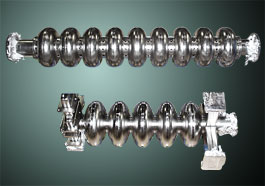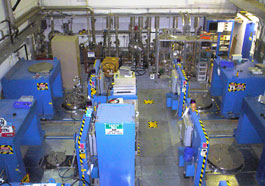
Like Jefferson Lab's accelerator cavities, the ILC cavities are built of niobium and are designed to operate at a frigid 2 Kelvin. However, the ILC cavities have a different shape for reaching higher accelerator gradients (a cavity's ability to transfer energy into particles per unit of cavity length). They are also longer, consisting of nine cells per cavity versus the five-cell cavities in Jefferson Lab's own CEBAF accelerator.
The International Linear Collider (ILC) is designed to collide high-energy electrons with high-energy positrons (electrons' antimatter counterparts). Once built, the ILC will serve as a powerful tool for scientists to address many of the most compelling questions of the 21st century - regarding the fundamental nature of matter, energy, space and time, dark matter, dark energy, and extra dimensions.
A cadre of scientists and accelerator professionals have come together to plan and design the ILC as a truly international scientific project. Known as the ILC Global Design Effort (GDE), the collaboration is tapping Jefferson Lab's more than two decades of experience building, processing and installing superconducting radiofrequency (SRF) technology in some of the world's largest accelerators.
Recently, the Americas contingent of the GDE sent two prefabricated niobium ILC accelerator cavities - the components that will accelerate the electrons and positrons for experiments - to Jefferson Lab for initial screening and performance tests. Members of the Accelerator Division's Institute for Superconducting Radiofrequency Science & Technology processed, completed the final assembly of, and tested the first cavity. They found its accelerating gradient, its ability to stuff energy into particles, was 30 Megavolts per meter (MV/m).
"It is the first nine-cell ILC cavity tested at JLab and the first in the U.S. to reach this gradient level," says Robert Rimmer, the Director of the Institute. "Significantly for us, it is by far the highest gradient multi-cell cavity ever produced at JLab and shows the fruit of our program to systematically improve quality and eliminate field emission in accelerating cavities."
While Jefferson Lab's own Continuous Electron Beam Accelerator Facility (CEBAF) is a dedicated nuclear physics accelerator, Jefferson Lab staff members possess extensive knowledge and experience in successfully designing, testing, and processing SRF accelerator cavities, making them valuable assets to the research and development team of new cavities for the ILC.
First-Class Cavity Processing
Even though the ILC is designed for high-energy particle physics, the GDE needs the expertise developed in the construction and maintenance of the ILC's much lower-energy cousins. Charles Reece, a senior scientist in Jefferson Lab's Accelerator Division, says he's not surprised that the GDE sent the cavities to Jefferson Lab for testing.
"Over 2300 SRF cavity tests, on a wide variety of cavity types, have been performed in the JLab Vertical Test Area since it was commissioned in April of 1991," Reece says, "This includes all of the cavities for CEBAF, the JLab Free-Electron Laser, the Spallation Neutron Source, prototype cavities for the Rare Isotope Accelerator, the Pion Linear Accelerator, and many other R&D cavities produced locally and internationally."
John Mammosser, who led the testing, says the Institute has used its expertise to design and implement a process for properly handling each cavity tested. "And we have a lot of flexibility designed into our process, which actually allows us to change things fairly quickly. It's the right way to go for production," Mammosser comments.
Accelerator cavity testing is a rigorous process. When a cavity arrives, it is first visually inspected for defects and fitted to the radiofrequency (RF) system to see how uniformly the cavity stores RF energy for accelerating particles among its nine cells, or how well it's "tuned." The cavity is then subjected to a thorough cleaning and assembly process, where it is cleaned with acids, rinsed with ultra-pure water, ultrasonically degreased, rinsed again, tuned with the RF system, heated in a furnace to remove hydrogen introduced by the acids, subjected to another short acid treatment, rinsed again, degreased again, rinsed for the first time with a high-pressure ultra-pure water system, partially assembled, high-pressure rinsed again, fully assembled, placed under vacuum, checked for vacuum leaks, and finally installed in the Vertical Test Area for testing.

Jefferson Lab’s Vertical Test Area
Mammosser and his team have worked on optimizing this process for high-end, high-power cavities. Their work has focused on two areas: eliminating contamination throughout the entire process and developing a better acid cleaning technique.
Preventing Invisible Dust Devils
"Almost everything you do in the assembly process creates particles. And this is essentially dust particles of all natures. Now these are particles that mostly you can't see, and lots of them," Mammosser says. If these dust particles aren't cleaned away, they can heat up and begin releasing electrons that interfere with the particles you're trying to accelerate, a problem called field emission.
"Not everything field emits in the cavity. But everything has an opportunity to," Mammosser explains. He placed a particle counter in the cavity assembly room to record the amount of particles each assembly task kicks up as swirls of invisible dust.
"We mounted a camera on a little tripod that went underneath the cavity and pointed in the direction of where the particle counter was. So you saw the actions of the person and the particle counts," Mammosser says. "So it was really intuitive to look at it and say we need to change this and we need to change that."
He and his team eliminated or modified the steps that created the most contamination. He says most modifications consisted of preparing tools and assembly pieces needed for the process beforehand and designing and constructing additional tools, such as an articulating arm that swivels to place pieces on the cavity.
"It's essentially using tooling to your advantage to connect the components with the least amount of particulate generation," Mammosser explains. The result is a cleaner processing environment and a marked reduction in the number of cavities exhibiting field emission, a cavity performance killer.
Jefferson Lab's Electropolishing Technique
The second major focus of the cavity preparation optimization program was designing a better acid cleaning technique. Currently, there are two standard processes for cleaning SRF cavities for assembly.
In the Buffered Chemical Polish (BCP) technique, each cavity is dunked in a witches' brew of cleaning acids (nitric acid, hydrofluoric acid, and phosphoric acid) and then thoroughly rinsed with purified water. For a long time, BCP dominated the cavity preparation process, and it is still the preferred process for lower-performance cavities. Recently, however, a second method has risen to the fore for high-performance cavities: electropolishing.

John Mammosser and team member Scott Williams exhibit Mammosser's custom-built cavity support stand, which was modified to handle ILC cavities. The Electropolish Cabinet sits in the background.
In the Electropolish (EP) technique used at Jefferson Lab, each cavity is lashed onto a custom-built gurney, rigged with electrodes and wheeled into a cabinet. The cavity is then half-filled with acid and slowly rotated through the acid, much like a turkey is turned on a spit over a fire. "The recipe consists of nine parts sulfuric acid, 96% concentrated, and one part hydrofluoric acid, 48% concentrated," Mammosser says. "It's quite a nasty electrolyte."
As the cavity is turned, the electrodes zap the cavity, setting off chemical reactions between the cavity surface and the acid that etch away an exceedingly thin layer of niobium (150-160 micrometers of material), along with any grit and grime, from the cavity's surface.
Mammosser designed the cavity support stand and the electropolish cabinet. He says the cabinet was constructed of special materials. "Sulfuric acid is essentially battery acid. It eats every type of material it comes into contact with, even plastics," he says. "The only thing that really survives it is Teflon, which is almost the entire surface of the process cabinet."
More to Come
"Electropolishing is very expensive and requires a special setup. However, with today's better performing cavities, it's the best recipe out there," Mammosser says. Still, Mammosser says the technique can't help cavities that may contain some other type of defect that electropolishing is not designed to correct. For instance, the first ILC cavity his group tested only reached an accelerating gradient of 30 MV/m, while it was designed to reach 35 MV/m. The problem was a "quench" - the cavity's gradient simply could not be pushed any higher.
He suspects this ILC cavity contains a defect. "Most quenches are typically material defects or something heating up on the niobium somewhere near where they're joined together by electron-beam welding. Almost every cavity that reaches a quench limit is limited there. And that is the case with this cavity, so it's highly likely that it is a material defect," Mammosser says, "So it's not the limitation of the procedures or the process but more likely the materials that were used or the steps that were used in fabricating the cavity."
Mammosser says, all-in-all, he's happy with the cavity's performance, and he's confident that future cavities processed by the group will also exhibit good performance. In addition, he's anxious to continue the cavity preparation optimization program. "We aren't done yet. There are still other ways we can optimize the process to make it even more cost effective and to ensure we get the best performance possible out of each cavity we process."
Coming up in the next newsletter: A Witness Protection Program for Accelerator Cavities.

